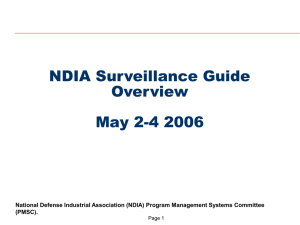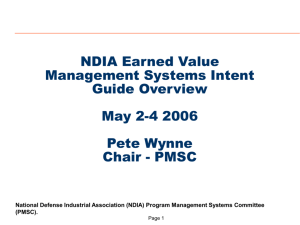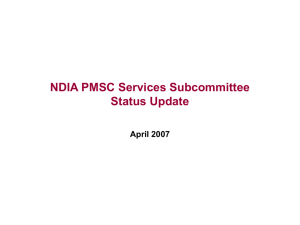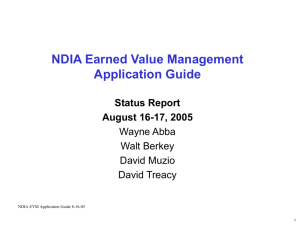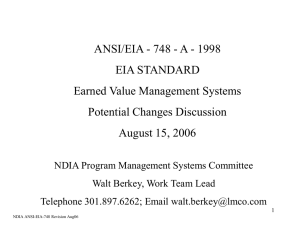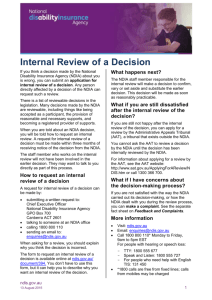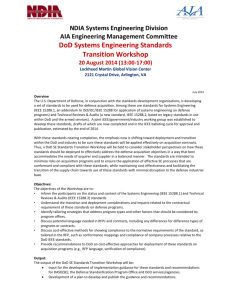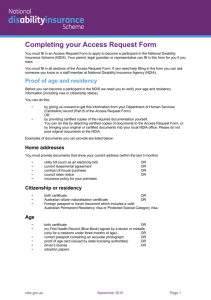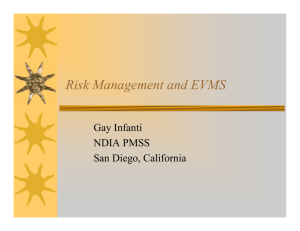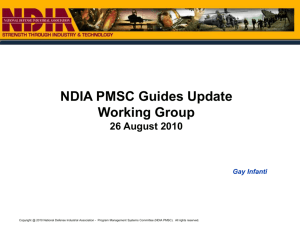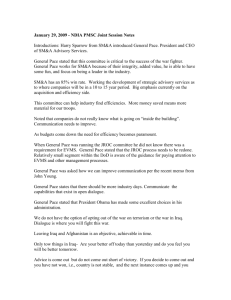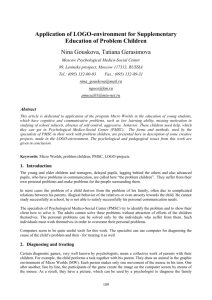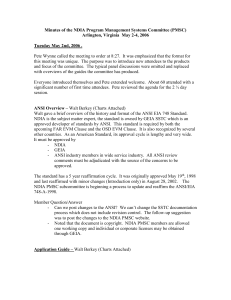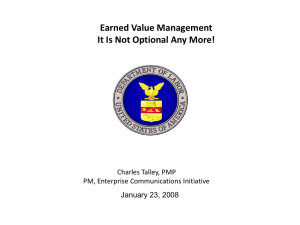NDIA PMSC Notes August 24, 2004 - National Defense Industrial
advertisement
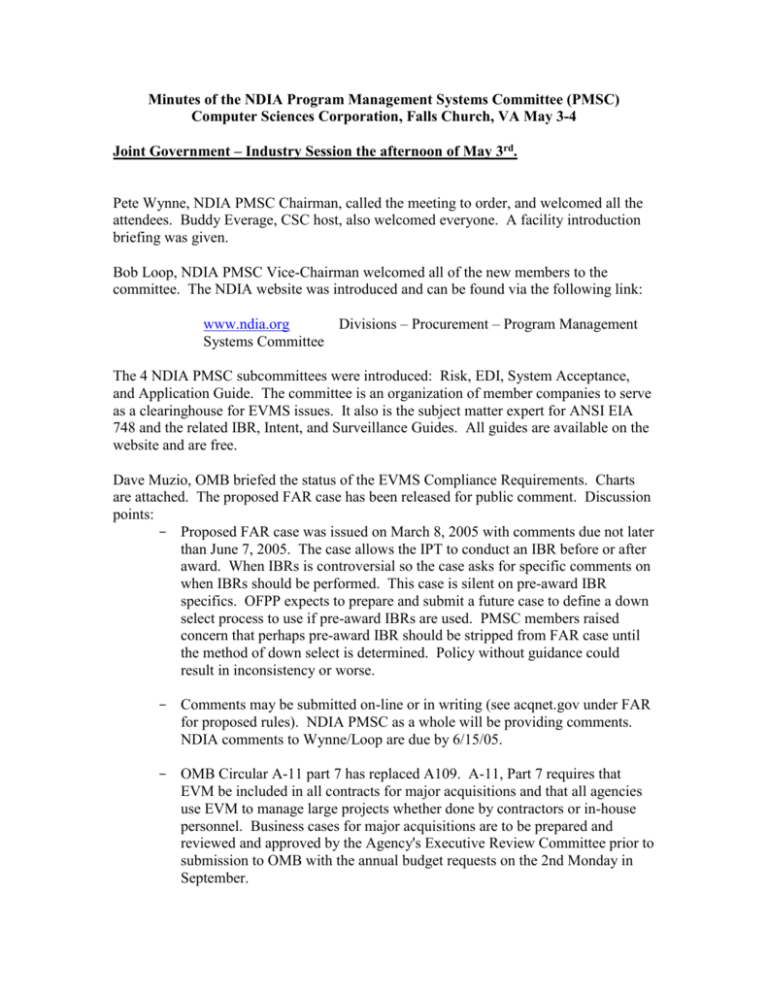
Minutes of the NDIA Program Management Systems Committee (PMSC) Computer Sciences Corporation, Falls Church, VA May 3-4 Joint Government – Industry Session the afternoon of May 3rd. Pete Wynne, NDIA PMSC Chairman, called the meeting to order, and welcomed all the attendees. Buddy Everage, CSC host, also welcomed everyone. A facility introduction briefing was given. Bob Loop, NDIA PMSC Vice-Chairman welcomed all of the new members to the committee. The NDIA website was introduced and can be found via the following link: www.ndia.org Divisions – Procurement – Program Management Systems Committee The 4 NDIA PMSC subcommittees were introduced: Risk, EDI, System Acceptance, and Application Guide. The committee is an organization of member companies to serve as a clearinghouse for EVMS issues. It also is the subject matter expert for ANSI EIA 748 and the related IBR, Intent, and Surveillance Guides. All guides are available on the website and are free. Dave Muzio, OMB briefed the status of the EVMS Compliance Requirements. Charts are attached. The proposed FAR case has been released for public comment. Discussion points: - Proposed FAR case was issued on March 8, 2005 with comments due not later than June 7, 2005. The case allows the IPT to conduct an IBR before or after award. When IBRs is controversial so the case asks for specific comments on when IBRs should be performed. This case is silent on pre-award IBR specifics. OFPP expects to prepare and submit a future case to define a down select process to use if pre-award IBRs are used. PMSC members raised concern that perhaps pre-award IBR should be stripped from FAR case until the method of down select is determined. Policy without guidance could result in inconsistency or worse. - Comments may be submitted on-line or in writing (see acqnet.gov under FAR for proposed rules). NDIA PMSC as a whole will be providing comments. NDIA comments to Wynne/Loop are due by 6/15/05. - OMB Circular A-11 part 7 has replaced A109. A-11, Part 7 requires that EVM be included in all contracts for major acquisitions and that all agencies use EVM to manage large projects whether done by contractors or in-house personnel. Business cases for major acquisitions are to be prepared and reviewed and approved by the Agency's Executive Review Committee prior to submission to OMB with the annual budget requests on the 2nd Monday in September. - Business case scoring FY2005/2006. Scored against 10 criteria each with a maximum of 5 points. An average score of 3 or less makes the “watch list”, a score of 2 or below is considered ineffective and not recommended for funding. There are specific requirements for the use of EVM in the President's Management Agenda (PMA) for the initiatives of E-Government and Budget and Performance Integration. One of the requirements is the use of EVM to achieve program/project cost, schedule and performance goals. Agency achievement of the PMA requirements are included on a scorecard with ratings of Red/Yellow/Green. The rating are updated every quarter and are available at www.results.gov, the end of year scorecard is contained in the President's proposed budget to submitted to Congress. - All agencies are required to conduct system compliance reviews by A-11, Part 7 now, and will be required to conduct surveillance activities and IBRs when the FAR case is finalized. Agencies must develop policies and procedures to meet these requirements. OMB recommends that all agencies use the DOD EVMIG and the NDIA Guides as "best practices" that civilian agencies should use to develop their processes. OMB is also very supportive of the PMSC efforts to develop both an EVMS Acceptance Process Guide and a full EVMS Implementation Guide. The OMB long range goal is to have these Guides accepted by both industry and the Government as standard practices whereby if a government agency or an industry firm accepts an EVMS system then all parties would accept the system. - This will require that the civilian agencies receive additional training. OFPP issued Policy Letter 05-01, on April 15, 2005, on Developing and Managing the Acquisition Workforce. As a minimum all agency Program/Project Managers and Contracting Officers will be required to be certified as having a common set of core competencies along the lines of the DAWIA requirements for DOD personnel. The Federal Acquisition Institute is working with DAU to develop the training. GSA has established a training fund to support the training of civilian agency personnel. Agencies administering interagency contracts will credit 5% of the fees collected under these contracts to the fund. - Can the Chief Acquisition Officers as a group be used to coordinate implementation issues? Dave yes, they are all political appointees charged with the responsibility to oversee the improvement of acquisition in their agencies. The Council will have subcommittees that can review and recommend action on issues brought before the Council. - - NDIA will be the focal point for EVM practices. Debbie Tomsic, OSD, briefed the status of the revised DoD EVM policy. The slides are attached (updated by Debbie post the meeting). - The revised policy was approved on March 7 and applies to contracts awarded in response to solicitations or requests for proposal issued on or after April 6. - All of the policy change recommendations except one were approved. The policy with regard to the use of EVM on FFP contracts has not changed. The use of EVM on FFP contracts is discouraged and requires the approval of the Milestone Decision Authority. While this policy appears to conflict with the guidance in OMB Circular A-11, the instances of noncompliance will be rare. OMB's focus is on development efforts, which do not typically use FFP contracts in DoD. - The changes to DoD Instruction 5000.2 to reflect the revised policy are in the works. The Defense Acquisition Guidebook is also being updated to include guidance to support the policy. Pete Wynne asked for further issues. - It was noted that GAO has begun using EVM information in program audits. Congress is being presented TCPI information in briefings. In the future they are looking to incorporate critical path scheduling metrics. Pete Wynne adjourned the meeting at 4:15pm. Joint Government – Industry Session May 4th. Pete Wynne, NDIA PMSC Chairman, called the meeting to order, and welcomed all the attendees. Buddy Everage, CSC host, also welcomed everyone. A facility introduction briefing was given. - The DoD EVM policy has been clarified and strengthened with the goals of increasing its effectiveness, driving consistency across DoD programs, streamlining reporting, and using industry best practices to better manage the programs. A panel discussion was conducted in the morning. Dr. Nancy Spruill represented OSD, Dave Muzio represented OMB, Peggy Poindexter represented NGA, and Pete Wynne represented NDIA PMSC, and Steve Kripkovich represented DCMA. There was significant discussion, a summary of which is noted below. - The DoD EVM policy has been clarified and strengthened with the goals of increasing its effectiveness, driving consistency across DoD programs, streamlining reporting, and using industry best practices to better manage the programs. - OMB interested in listening to other agencies and about other agencies listening to OMB. - Approximately 75% of current DCMA validation activity is with subcontractors. - DCMA focus on EVMS metrics approach to evaluate quality of the EVMS process. - EVMS validation needs to include surveillance requirements - Discussion of if the NDIA PMSC guides should be raised to standards. It was felt that civilian agencies can implement based on a guide. - The DCMA and Intel community are beginning to share EVMS surveillance results. Gay Infanti, Northrop Grumman; and John Driessnack, MCR co-leads, briefed the status of the Risk Subcommittee. The charts are attached. Notes: - The charter on page 3 was amended to integration recommendations instead of process guidance. - There is risk guidance in the EVMIG of how to apply the IMS DID requirement. Joan Ugljesa, AIM, briefed the status of the XLM working group. Charts are attached. Discussion: - The main purpose of the subcommittee is to migrate the ANSI X12 transaction sets to a scalable XML schema format. This can be used to send IMP/IMS, CPR, and CFSR data as well as related data. The XML schema format will incorporate the recent changes to the CPR data item description (DID) as well as the new IMS DID. - The sponsor for the XML work was Air Force. Due to a change in personnel at the CIO level there may need to be a different sponsor. The chairman encouraged Joan to develop the schemas even if the sponsor issue is delayed. Types of information that can be transferred: - Integrated Master Plan/Integrated Master Schedule (IMP/IMS) data - Structures such as WBS and OBS - Schedule and fiscal calendars - Activity, milestone, relationship, and resource assignment data - Thresholds - Traditional CPR and CFSR data - Time phased cost data The schemas will be more flexible and allow the ability to select content (modular approach). Walt Berkey, Lockheed Martin briefed the status of the Application Guide Subcommittee. Charts are attached. Notes: - A draft is planned to be completed by July 30th. A question was raised regarding government review and comment. Due to the high priority of this task we will need to incorporate the government comments in the same cycle as industry’s. Comments are going to be obtained as part of the August PMSC meeting, scheduled for the 16th of August. - Guide is targeted for release on or about December 1st. This is not a fixed date and does require the FAR Case issued on pre-contract IBRs to be understood by NDIA and OMB. Buddy Everage, CSC; briefed the status of the System Acceptance Subcommittee. The slides are attached. Notes: - The customer for the guide is OMB. - Main concern raised was the 3rd party EVMS credentials. How the certifier is qualified and how is quality of the review assessed? - Team Schedule: Did not have a presentation to the wider NDIA PMSC body in the plan. The vice-chair pointed out this is required in the charter. Buddy took an action to revise the schedule. - The goal is publication of a guide by November 2005. To meet this goal a draft will need to be presented to the full committee at the August 2005 session. - Team Members: Added Steve K., Dave Treacy, Robbie Robinson. - The introduction section is completed. The remaining sections will cover both the customer, third party, of self variations. - A member noted that it might be possible to skip from step 4 self-certification to step 7 System Acceptance if there is not a contractual requirement. - There were lengthy discussions and disagreements among the team members. The chair and vice chairman need to emphasis it is the responsibility of the team leaders to send material out to team members prior to the meeting and the responsibilities of team members to address concerns with the subcommittee first before raising to the larger body. Pete Wynne adjourned the meeting. The next meeting is scheduled for August 16-17 in Destin Florida and will be hosted by C/S Solutions. The flowing meeting has been scheduled for January 31 – February 1st in San Diego California and hosted by Dekker Limited. -
